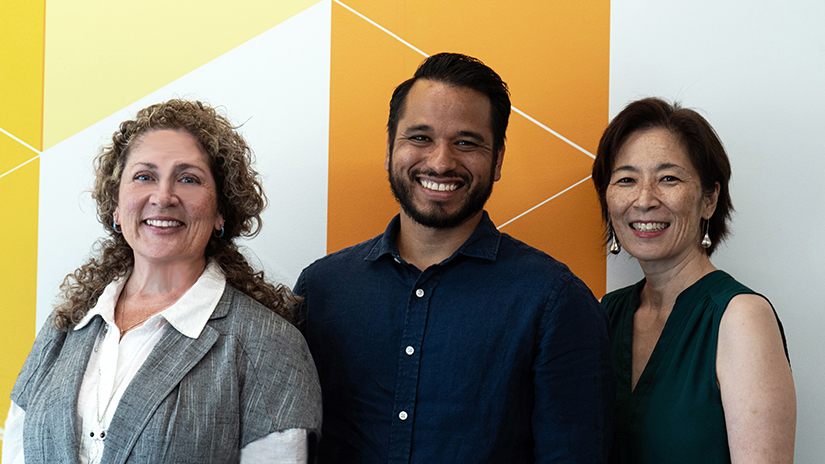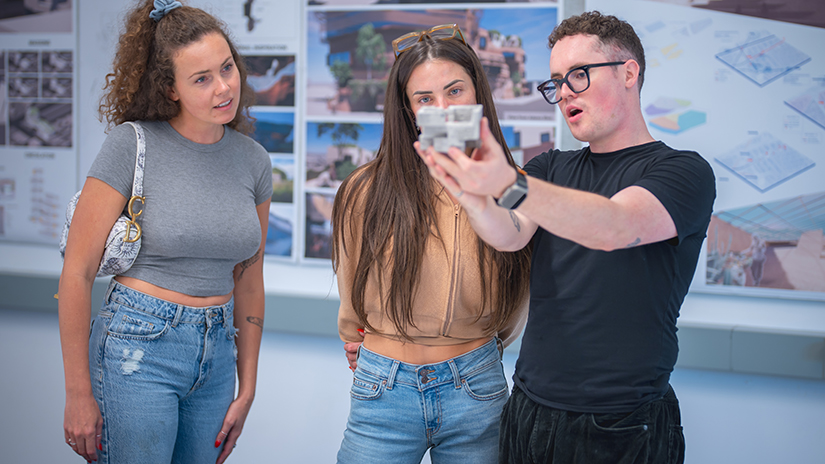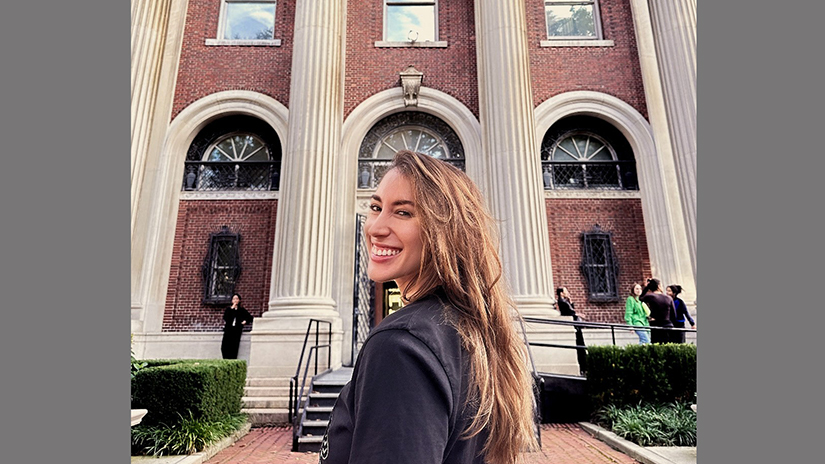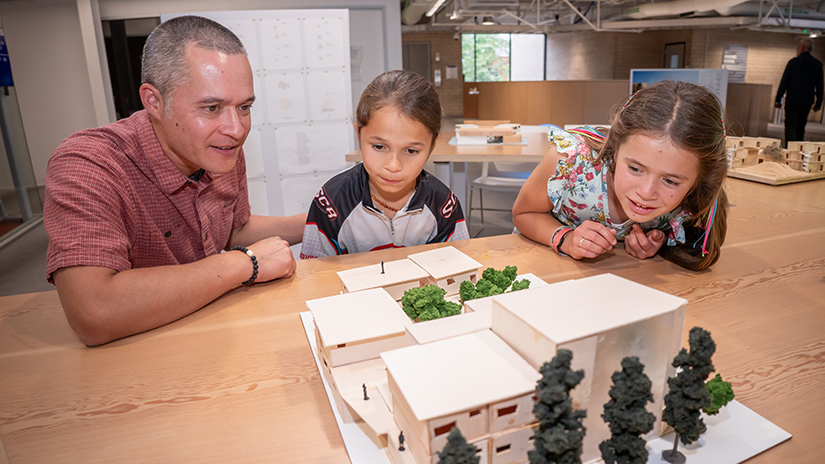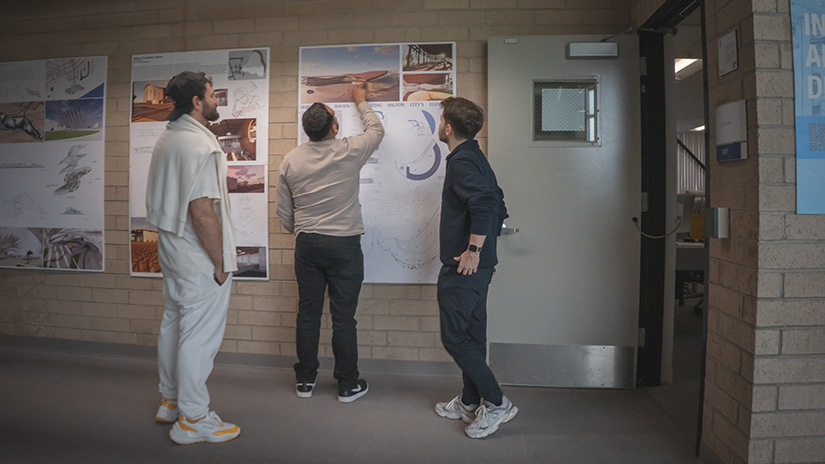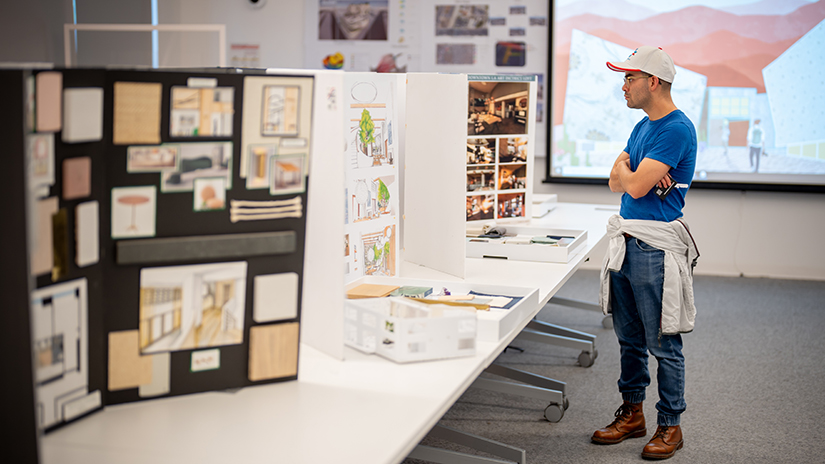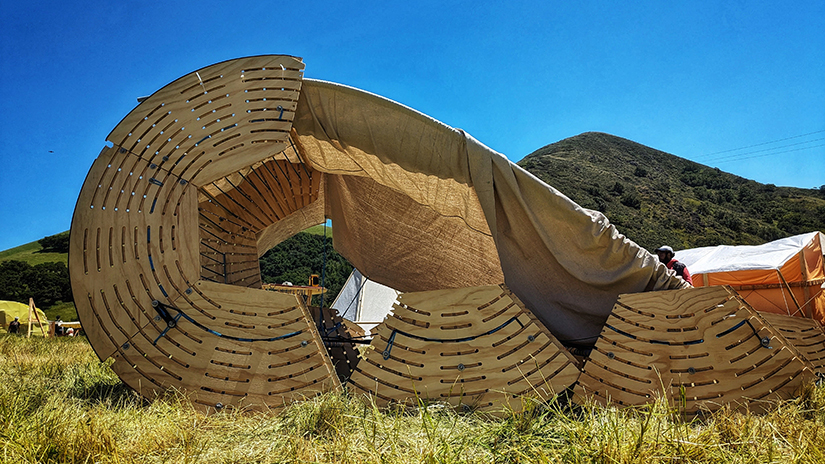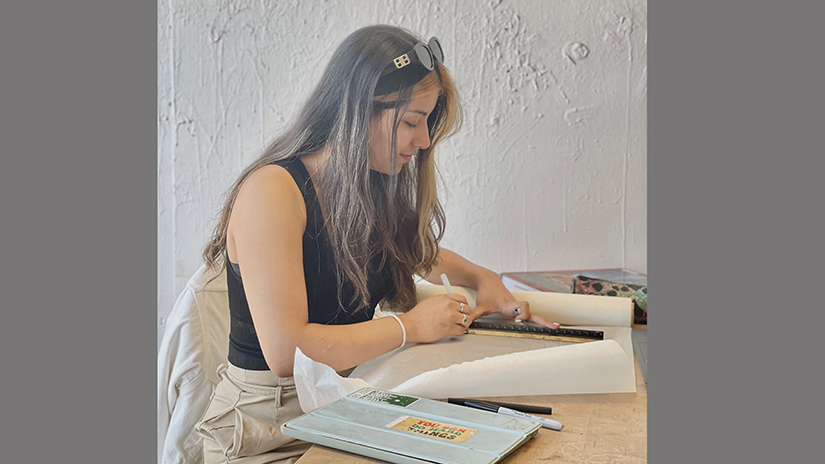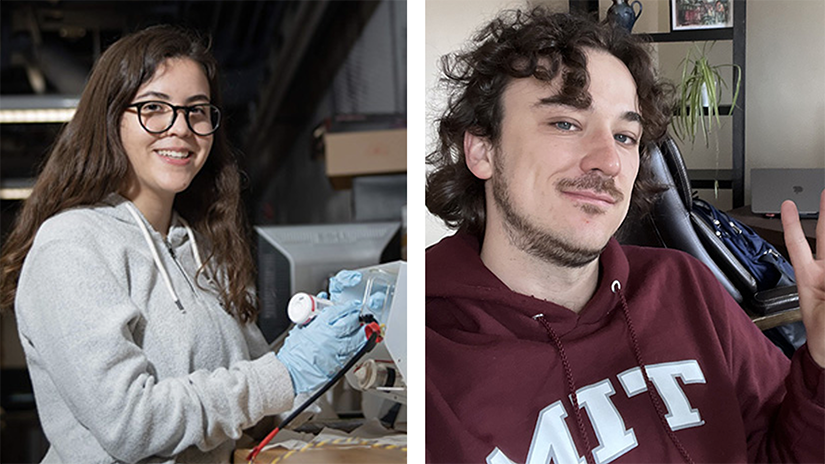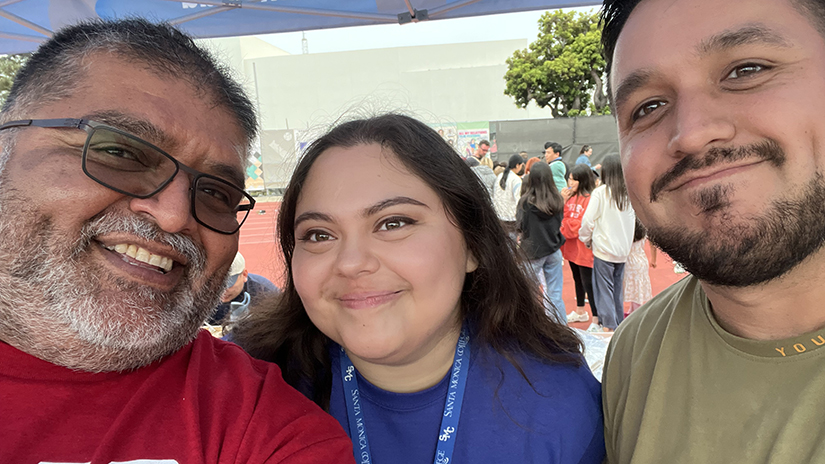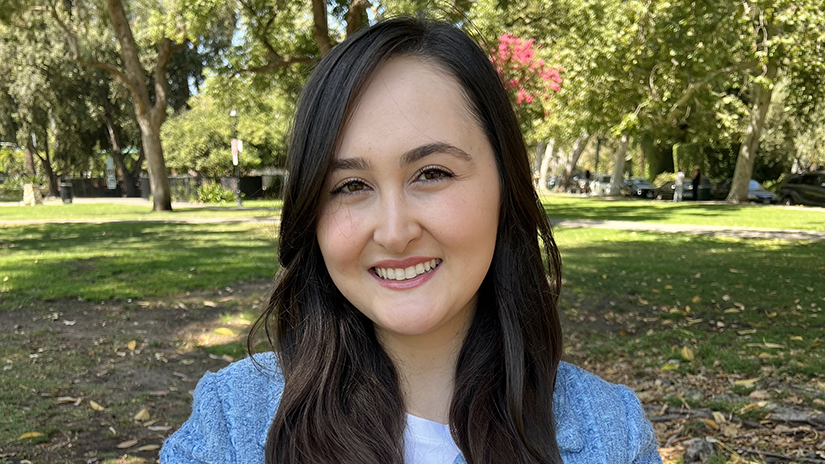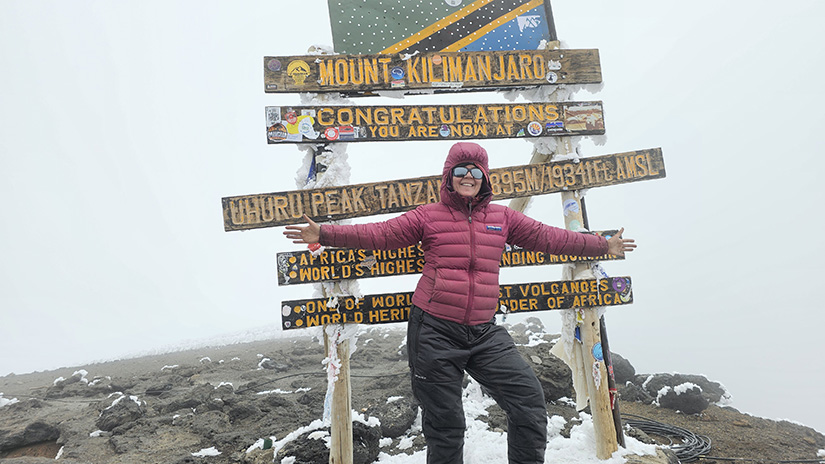
Under Sheila Cordova (opens in new window) , chair of the Design Technology department, a reimagined program is preparing Corsairs for a profession undergoing tectonic shifts in the information age.
In today’s architectural design workspace, advanced computing skills using highly specialized tools are de rigueur. AI makes it possible to transform elaborate renderings on the fly. Tasks that used to take days—such as switching out construction materials, revising landscaping choices, even altering the underlying architectural style—now take minutes and can be executed in countless iterations.
At the same time, conceptual originality and critical thinking have never been more in demand.
It is in this context that Architecture has made a comeback at SMC. After a 20-year pause, Sheila, together with Josephine “Jo” Hao (opens in new window) , revived the program in 2020, integrating it with the existing Interior Architecture Design (IArc) program.
“We wanted to give students more options,” says Jo, who leads IArc.
The distinction between IArc and Architecture is subtle but important. One discipline focuses on human interaction with space, emphasizing interior furnishings and finishes (think airport and hotel configurations). The other addresses building forms and site context. And while they share some curricula and technology, the credentials and careers they lead to aren’t necessarily the same.
Javier Cambron (opens in new window) was hired in 2020 to co-lead the reconstituted Architecture program and expand IArc. One of the courses he regularly teaches is Studio 2.
At the core of a traditional architecture education lie a series of four design studios. They aren’t always available at two-year colleges, however.
Both Sheila and Javier had experienced first-hand the frustration of transferring from community colleges without any studios on their transcripts. They learned the hard way that backloading these foundational courses needlessly drags out what should be a five-year undergraduate education.
“It took me almost 10 years to complete my BArch degree,” says Javier, who was relegated to first-year status at SCI-Arc (opens in new window) after earning an associate degree in architecture from Rio Hondo College. (opens in new window) “It’s a very common story for community college students in architecture,” he says.
“Javier and I are both pretty passionate about making sure that our students don’t have that same journey,” says Sheila, who had transferred from Victor Valley College (opens in new window) to Iowa State University (opens in new window) , where she was obliged to take her studios sequentially, not concurrently. It set her back four years.
The new Architecture program includes all four design studios. Similar studios already existed in the IArc program but were not fully compliant with BArch standards. The challenge was to reconfigure them so Corsairs could seamlessly transfer to five-year BArch programs at the third-year level.
Articulation agreements are now in place at seven California architecture schools, and more are in negotiation.
Two related certificate programs offer pathways into architecture-adjacent fields such as drafting and computer-assisted design. These non-degree tracks lead to job-ready skills and immediate career opportunities.
And jobs are plentiful. With housing shortages reported across America, the building sector of the economy is in expansion. According to U.S. Bureau of Labor Statistics (opens in new window) , the market for architects will grow by 8 percent over the next 10 years.
SMC enrollments reflect these trends. A combined 150 students pass through the IArc and Architecture programs annually, including a large number of international students. The student body is notable for its diversity, as evidenced by the dynamism of NOMAS, (opens in new window) the student wing of the National Organization of Minority Architects. (SMC is one of only four community colleges to have a chapter.)
Javier is the club’s faculty co-adviser along with colleague Michael Rocchio. They have taken members to two major competitions. Last year, five Corsairs won the top prize for “most innovative design” in the Design Village (opens in new window) challenge, hosted by Cal Poly San Luis Obispo (opens in new window) . The contest called on teams to build a hillside dwelling in a canyon, carrying all their building components on foot, and to inhabit the structure for a weekend. Using a roly poly bug as their inspiration, the design team built a biomimicry-based dwelling out of wooden modules that could be reconfigured as a giant wheel and rolled to the building site along the 1.5-mile dirt trail. Later this month, the club will travel to Baltimore to participate in a national competition during the annual NOMA conference (opens in new window) . [Editorial Note, 10/28/24: SMC made it to the final round of the competition, and earned a "Special Recognition Award"--a first for a U.S. community college].
Avalon Rossi, 30, is a past president of the club. Now in her second year of a master’s program at Columbia University’s Graduate School of Architecture, Preservation, and Planning, the Long Beach native had been a contractor-owner-builder for several years when she came to SMC in 2020. At the time, Avalon and her mother ran a successful business buying, renovating and reselling historically and architecturally significant homes. After overseeing 15 full-scale renovations from Palm Springs to San Diego, Avalon was at a turning point: being a general contractor was no longer enough. “I wanted to go deeper,” she says. “To have full design control, from concept to end. To be able to do it all.”
With a bachelor’s in English and film from UCLA, she could have gone straight into an MArch program, “but I’m so happy I didn’t do that,” she says. Instead, she signed up for SMC’s Certificate of Achievement.
“Architecture is very software intensive,” Avalon says. “I can’t even imagine starting my program at Columbia without having prior knowledge of the technical side of things”—tools like 3D modeler Rhino, visual programming language Grasshopper, and building information software Revit.
Avalon heaps praise on Javier and the other hard-working SMC Architecture faculty (“special shout-outs to Michael Rocchio, David Gonzalez and Will Ellsworth,” she says.)
“The teachers at SMC are very grounded in the working world; they’re involved in real projects in Los Angeles,” she notes. “Yet every single teacher was always very willing to mentor me and talk with me. And not just with me. They do that with every student.”
When Avalon finished her certificate in 2022, she felt “very sad to leave SMC.” In her role as NOMAS club president, she had gotten to know top LA architects like Flora Lee, Patricia Rhee, Ronald Rael and Leo Marmol, and she felt rooted in the community. But she’s thriving at Columbia and happy with her decision.
Ale Cacacho, 20, is one of the many international students choosing SMC for architecture.
The Guatemalan-Salvadoran national was already admitted to University of Utah when a family financial setback pushed tuition for the BArch degree out of reach. Ale came to SMC instead, “and I’m really grateful I did,” she says, “because as an international student, everything was so new. Architecture is already a very demanding major. Spending my first two-and-a-half-years at a community college allowed me not only to save money but also be introduced to the field in a less overwhelming way. And I’m at Cal Poly SLO now, which has a higher-ranked BArch program than University of Utah.”
After she graduates next spring, Ale hopes to find employment in San Francisco with a small- to mid-sized architectural firm specializing in residential projects.
Sheila is proud of what she and her colleagues have accomplished in just four years. Asked about her vision, she says: “I see our students as the architects of tomorrow, shaping a future of design that prioritizes sustainability, inclusivity and innovation for a better world.”
* * *






